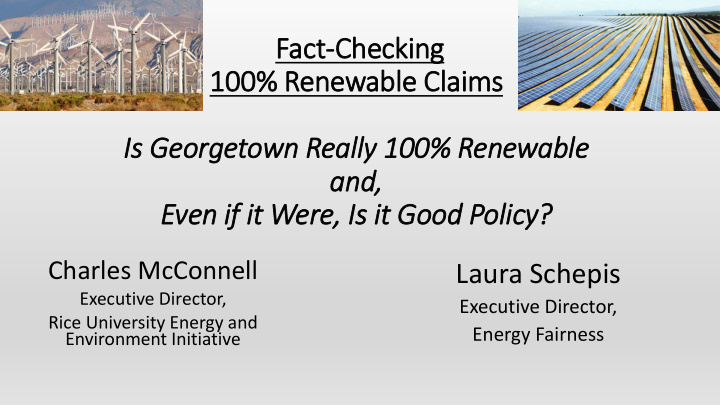



Fact-Checking 100% Renewable Cla laims Is Is Georgetown Really 100% Renewable and, , Even if if it it Were, Is Is it it Good Policy? Charles McConnell Laura Schepis Executive Director, Executive Director, Rice University Energy and Energy Fairness Environment Initiative
Why We Are Here Part One (Chuck McConnell): • 100% Renewable Claims – and the reality for Georgetown and TX • Is Georgetown a Taker or a Maker ? Part Two (Laura Schepis): • State of the National Grid • Reality Check on Energy Storage
Part One: 100% Renewable Claims • No Pure Electrons • Not Enough Wind at Peak – but “thankfully” we have the rest of Texas’ grid and supply Is Georgetown a Taker or a Maker? • Who is Paying for It? • Is Georgetown Really Moving the Needle?
Summer of f 2018 • New Record Consumption Every Day! (72-74 GW!) • Gas, Coal, and Nuclear, Meeting the Challenge (69-71 GW) • Wind No-Show & very little Solar Results in < 5-8% of total needs. Gap Between Perception & Reality Remains Huge
Who is Paying For It It? US Taxpayers: $36 Billion in Wind & Solar Tax Subsidies (2016-2020) • Paid by all US Taxpayers (including those with no feasible way to generate wind/solar) • Hidden in our Tax Bills (Not in our Utility Bills) Texas Ratepayers: $7 Billion in Renewable Energy-Driven Transmission Lines • Paid by all Texas Customers (not allocated to renewables dependent on lines) • Nothing on Utility Bills Explaining that Cost of Renewables Texas Property Taxpayers: $ 1.8 Billion in Chapter 313 Renewable Property Tax Breaks • Comptroller documented this subset - there are other local tax breaks too. • Public school finance system is impacted. • Wind & Solar claim local benefits, but they are largely exempt from local taxes due to agreements. The Grid: Untold Billions in System Integration Cost & Market Distortions • Renewables not required to “balance” their intermittent power. • Reliable sources (gas, coal, & nuclear) forced to wait to fill the gap with inadequate compensation • Subsidy-driven negative pricing destroying capital, stranding assets, and endangering reliability.
“ All ll Fuels Are Subsidized ” Tru rue, But What Do We Get for Our Money? Return on Investment (ROI) Dollars in subsidy received per megawatt hour produced ($MWhr) Sources: Institute for Energy Research (2011)(based on EIA data); Congressional Research Service (2017); Department of Energy (2018).
Will ill a 100% Renewable Grid id in in the U.S .S. Measurably Im Impact the Clim limate? 8
Part Two: State of the National Grid • Where We Are Projected to Go • Expert Studies on Feasibility of 100% RE Reality Check on Energy Storage • Only Way to Conceive of 100% RE • Very Long Way to Go
Where We Are Projected to Go
Expert Studies - Feasibility of 100% RE
Storage – Much Work Lie ies Ahead • Extremely High Cost (Lazard Study) • Dependent on Rare Earth Metals Controlled by Chinese • Customization – software connectors between battery and energy source are very specific to site and function. • Cars - Vehicle to grid not mature enough for IRP process.
U.S. Storage Snapshot • EIA “Energy Storage Overview” presented June 5, 2018 • At end of 2017, U.S. had 664 MW of power and 742 MWh of energy in operational large-scale battery capacity. • “The total capacity of grid -connected energy storage projects in the U.S. is equivalent to 2 percent of the nation’s electricity generation capacity.” Environment Texas report, December 2017.
Texas / ERCOT Storage Snapshot EIA’s 2018 report concluded that ERCOT had: • 83MW of large-scale battery storage • 41MWh of large-scale battery storage energy capacity. Remember: Gap Between Peak Needs and Wind/Solar Production in ERCOT is . . . 69,000- 71,000 Megawatts!
Recommend
More recommend